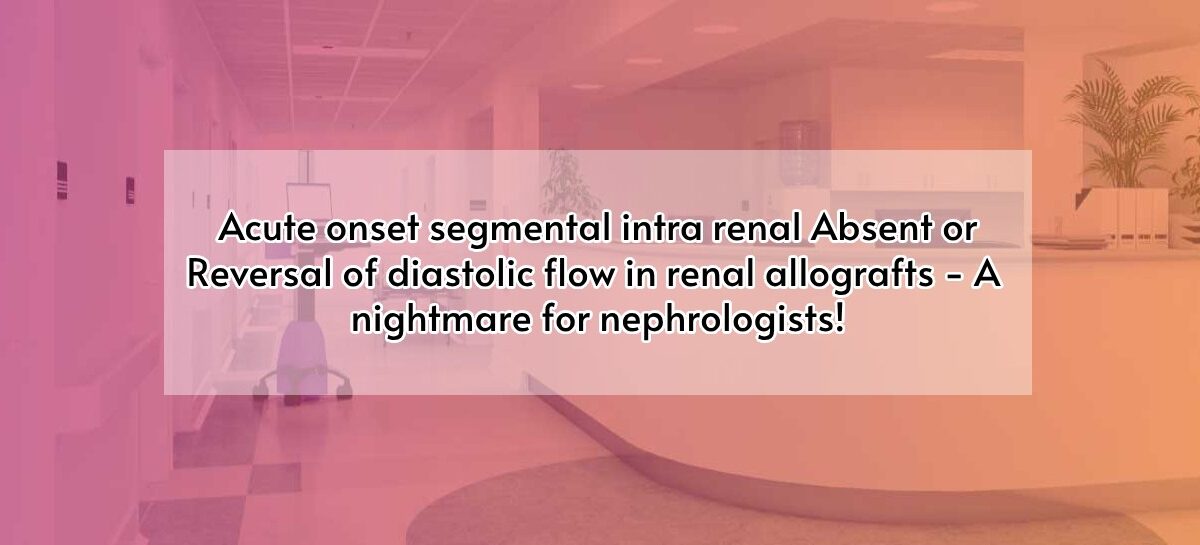INTRODUCTION:
Doppler Ultrasound (DUPLEX) has proven to be a useful non-invasive tool for monitoring the renal allograft function. In the healthy allograft, low renal vascular resistance allows antegrade blood flow throughout the cardiac cycle. In the dysfunctional kidney, high intrarenal vascular resistance can cause decrease / absent diastolic flow. Reversed diastolic flow represents the extreme end point of high vascular resistance. Although relatively rare, reversed diastolic flow demands immediate attention because it portends poor outcomes, with 33%–55% of allografts lost. Here we describe our experience with 2 such cases and management.
CASE REPORT 1
58-year-old male DDRT recipient had normal renal functions on follow up. Patient presented with acute onset fever, diarrhoea and oliguria. Inspite of fluid repletion, he became anuric with rise in creatinine of 4mg/dl within 24 hours. DUPLEX showed absent diastolic flow in renal artery at hilum with reversal of diastolic flow in intrarenal arteries(Fig 1). CT angiogram showed no evidence of RVT. Initial diagnosis of small vessel thrombosis due to HUS was made and emergency PLEX was done. Post PLEX within 24 hours DUPLEX showed normal flow pattern in intrarenal arteries. Investigations subsequently revealed HB-7gm, TC-16000, PLT-1lakh, LDH-629 IU/L , D-Dimer 3471ng/ml. Peripheral smear(Tear drop cells, Fragmented cells),Urine Hb-positive,INR-1.3.Tacrolimus level.(9ng/ml) and CMV-DNA PCR -11330 copies/ml, Blood C/S-E.coli. Treated with IV Ganciclovir and meropenem. Urine output gradually improved. A week later, Biopsy was done that showed Acute tubular injury without any evidence of HUS / rejection. Totally 3 sessions of PLEX and HD done. Renal allograft function improved with recent creatinine of 1.3mg/dl.
CASE REPORT 2
33-year-old female ESRD patient underwent LRRT (ABO incompatible –Desensitization done) with mother as donor(HLA match-5/6) and had normal allograft function till 6 months post trasnplant, then developed AKI (creat-2.5mg/dl).Biopsy showed combined ACMR(BANFF IA)and active ABMR (g1,ptc2),focal C4d positive with negative DSA(class I&II).Initially treated for ACMR with pulsing steroids followed by oral steroids. Creatinine improved from 2.5 to 1.8mg/dl.10 days later ,patient presented with acute onset oliguria, graft tenderness with rapid rise in creatinine 4.38mg/dl. DUPLEX showed normal vascularity in middle pole and no vascularity in upper and lower pole with infarcts region of allograft (Fig4).started on PLEX + IVIG. Investigations revealed PLT-1.2 lakh, D-dimer-2194mg/dl, Peripheral smear-Fragmented cells, tear drop cells. Anti-A titre normal. Blood c/s-No growth.
Renal function rapidly worsened and initiated on Dialysis. Despite 3 cycles of PLEX and IVIG, the vascularity in the middle pole was also lost (Fig4) and ended up with graft nephrectomy. Patient is back on dialysis.
DISCUSSION:
TMA appears in 0.8–14% of transplanted patients and negatively affects graft and patient survival. It can appear in a systemic form, with hemolytic microangiopathic anemia, thrombocytopenia, and renal failure, or in a localized form, with progressive renal failure, proteinuria, or arterial hypertension. Post-transplant TMA(PT-TMA) is classified as recurrent a HUS or de novo TMA. De novo TMA accounts for the majority of cases. Distinguishing between the 2 conditions can be difficult, given there is an overlap between them. Complement overactivation is the cornerstone of all post-transplant, and has been demonstrated in the context of organ procurement, ischemia-reperfusion phenomena, immunosuppressive drugs, ABMR, viral infections, and post-transplant relapse of APLA. Although treatment of the causative agents is usually the first line of treatment, this approach might not be sufficient. PLEX typically resolves hematological abnormalities.
CONCLUSION:
Though reduced intra renal diastolic flow is commonly seen in dysfunctional grafts, acute onset major flow issues like segmental absence of flow or diastolic flow reversal indicate microvascular obstruction mostly due to HUS, plasma exchange as an emergency procedure is graft saving. Reversal of diastolic flow is a medical emergency, so timely management is graft saving.
Reference:
1.TMA After Kidney Transplantation: An Underdiagnosed and Potentially Reversible EntityAna Ávila*, Eva Gavela† and Asunción Sancho†
2.Reversed Diastolic Flow in the Renal Transplant: Perioperative Implications Versus Transplants Older Than 1 Month-Lockhart et al.
 Dr. Vishnu Shankar
Dr. Vishnu Shankar
DNB (Nephrology PG),
Kauvery Hospital, Chennai.





